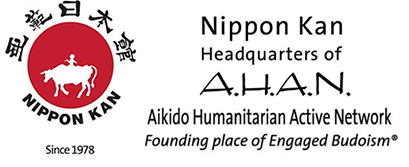Introduction from Homma Kancho
[catlist id=6 numberposts=10 date=yes]My name is Gaku Homma. I first came to the United States from Japan about 40 years ago. Since my arrival I have been teaching the Japanese martial art of Aikido. Including my studies in Japan, I have been practicing Aikido for more than 50 years. I would like to give you a bit of history about Aikido as I have experienced it during my lifetime.The practice of Aikido, founded by Morihei Ueshiba 1883-1969 (commonly referred to as “O’Sensei”) has spread from Japan to all corners of the globe.
Aikido, as with any sophisticated art, was not created by magic. O’Sensei and other Japanese masters developed Aikido following years of intense training and research in other styles of self-defense. Aiki Jujitsu and Daito Ryu Jujitsu were two martial arts O’Sensei, studied to develop Aikido. Today the organization founded by Ueshiba is called Zaidan Hojin Aikikai, or the Aikido Foundation, which is based at Hombu Dojo in Tokyo.
Names such as Aikikai Aikido, Hombu Aikido and Ueshiba Aikido refer to this same organization. In the United States, the highest percentage of dojos (martial art schools) are affiliated with Aikikai Hombu Dojo. The United States Aikido Federation (USAF) is the largest of these Aikikai federations in the United States. A few of O’Sensei’s students broke away from the Aikikai Foundation after his death in 1969. They formed their own organizations, such as Tomiki Aikido, Yoshinkan Aikido, and Ki Aikido.
As a child in Akita, a small city in Northern Honshu, I studied Judo, which for Japanese kids was as popular as baseball and basketball in the United States. At that time, Aikido was a new martial art. Before World War II Aikido was restricted to the elite and practiced by military leaders, Imperial dignitaries and top executives. It did not become generally popular until after World War II. Most of the television heroes I watched as a child studied Judo and wore a hakama (the outer garment worn as part of an Aikido uniform). These TV supermen inspired me just as Bruce Lee films motivated Americans to learn more about Asian martial arts. In that way, my path was probably not much different than yours!
I, however, had the good fortune to become O’Sensei’s student. I also served as his last live-in student. After O’Sensei’s death, I studied with many other high-ranking Aikido instructors. Before the end of World War II, O’Sensei moved from Tokyo to the town of Iwama, which is two hours northeast of Tokyo. There he built the Aiki jinja (Aiki shrine), and lived the rest of his life dedicated to the development of the art of Aikido.
During this time, Hombu dojo, located in Tokyo, was overseen by O’Sensei’s son, Kisshomaru Ueshiba. O’Sensei visited Hombu dojo about once a month, spending most of his time at the Iwama Aiki shrine. In his final years, O’Sensei received very few visitors at Iwama, keeping company mainly with his wife, Hatsu, and Morihiro Saito 1928-2002). O’Sensei became somewhat isolated with only his maid, Kikuno, and myself in attendance.
For the last year of his life, O’Sensei was moved to Tokyo, where he stayed until his death.It has been my belief that all Aikido organizations are part of the same family under the Founder, O’Sensei. After his death, I was not able to choose one organization over another. Instead, I studied Aikido independently.
I founded Aikido Nippon Kan in 1978 as an independent dojo. I created and developed my own system of study based on what I learned from O’Sensei.
Although Aikido Nippon Kan remains an independent organization, my loyalty will always remain with the Founder, Morihei Ueshiba. I maintain a close relationship with Iwama’s Aiki shrine dojo and other direct students of the Founder as part of the heritage of my youth.
In the years since O’Sensei’s passing, the late Morihiro Saito, 9th degree black belt, became a world-renowned Aikikai Shihan (master instructor) and also the chief instructor (dojo cho) of the Aikishrine Dojo in Iwama. He often spoke of the early days at Iwama and my relationship to the Founder. He has also attested that I am the last official uchideshi, or live-in student, of the Founder and the only person in the United States who can testify so personally about the O’Sensei’s final years. Until his death in the spring of 2002, Morihiro Saito was a special advisor to Aikido Nippon Kan.
Because Aikido Nippon Kan is an independent organization, the ranking certificates given for kyu (beginning through brown belt levels) and black belt levels are signed by myself as Nippon Kan’s Founder. Though we are an independent school, our roots are the closest to the Founder’s of any dojo in the United States.
At Nippon Kan General Headquarters, over 25,000 students have attended our beginner classes in over 40 years of practice. Aikido Nippon Kan offers 16 classes a week, instructed by myself or and my highly trained staff. All instruction is given under close supervision and is delivered with patience, kindness and humor. All students are trained to help each other, focusing on cooperation as a successful tool for learning. Beginning classes are tailored to the brand new student’s level, with great consideration given the student’s feelings and capabilities. This unique teaching method has been developed by myself and is outlined in my books: The Structure of Aikido, Vol. 1; Aikido for Life; Aikido Sketch Diary—Dojo 365 Days; Children and the Martial Arts: An Aikido Point of View; and The Folk Art of Japanese Country Cooking.
As Founder and Chief Instructor of Aikido Nippon Kan, I welcome you to join our beginning Aikido programs here at Nippon Kan and hope you enjoy learning Aikido at Nippon Kan.
Gaku Homma, Nippon Kan Kancho
Articles & Essays
Sensei’s Column
2015
4/21/15 This Old Man Does Not Need It Any More- Words of the Founder
3/25/15 Thoughts on the Plane: Flight UA1384 to Bangkok
2014
2/2/14 Aikido Without [Shu] and [Ha]
5/28/14 Do Not Teach Budo, If You Are Worried About Your Komebitsu
2013
12/14/13 Kashari-Fukashari: Out of the Dojo but Still in the Dojo
Published Books
The Structure of AIKIDO
The Structure of Aikido Part 1: Kenjutsu and Taijutsu (Sword and Open-hand Movement Relationships) 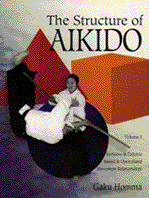 Published by North Atlantic Books, Berkeley, California; Domo Productions, Denver, Colorado; 1997 Paperback; 186 pages; $22.95 The Structure of Aikido Volume I: Kenjutsu and Taijutsu (Sword and Open-hand Movement Relationships) is a remarkable interpretation of the foundation of Aikido technique. Gaku Homma’s in-depth study of the relationship between Japanese swordsmanship and open-hand movement unites tradition with the contemporary development of the art of Aikido. Although the study of Kenjutsu and Aikido have long been associated, this is the first book in which actual Aikido techniques are related to technique sequences used with the sword. 1,600 frame-by-frame photos mirror the movement shared by both arts.
Published by North Atlantic Books, Berkeley, California; Domo Productions, Denver, Colorado; 1997 Paperback; 186 pages; $22.95 The Structure of Aikido Volume I: Kenjutsu and Taijutsu (Sword and Open-hand Movement Relationships) is a remarkable interpretation of the foundation of Aikido technique. Gaku Homma’s in-depth study of the relationship between Japanese swordsmanship and open-hand movement unites tradition with the contemporary development of the art of Aikido. Although the study of Kenjutsu and Aikido have long been associated, this is the first book in which actual Aikido techniques are related to technique sequences used with the sword. 1,600 frame-by-frame photos mirror the movement shared by both arts.
Aikido for Life
Aikido for Life Published by North Atlantic Publishing, Berkeley, California; 1989 Paperback; 112 pages;  $12.95 Aikido for Life offers a simple explanation of Aikido and how it can be used to train mind, breath and body. The book is similar in structure to the beginners class at Nippon Kan. Not only does it offer simple explanations and illustrations of basic Aikido movements and techniques, it also offers a look at the philosophy behind Aikido. Aikido for Life does not try to be simply an instructional manual. Rather, it explains how Aikido can help develop not only healthy bodies but a positive approach to life as well. Aikido for Life presents a teacher’s view of Aikido and was written for beginning and experienced students alike.
$12.95 Aikido for Life offers a simple explanation of Aikido and how it can be used to train mind, breath and body. The book is similar in structure to the beginners class at Nippon Kan. Not only does it offer simple explanations and illustrations of basic Aikido movements and techniques, it also offers a look at the philosophy behind Aikido. Aikido for Life does not try to be simply an instructional manual. Rather, it explains how Aikido can help develop not only healthy bodies but a positive approach to life as well. Aikido for Life presents a teacher’s view of Aikido and was written for beginning and experienced students alike.
Children and the Martial Arts
Children and the Martial Arts: An Aikido Point of View Published by North Atlantic Books, Berkeley, 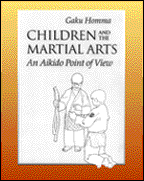 California; Domo Productions, Denver, Colorado; 1993 Paperback; 250 pages; $20.00 “I believe that martial arts training can be very good for children,” writes Gaku Homma Sensei in the Introduction of Children and the Martial Arts: An Aikido Point of View. “It teaches skills that help children deal with everyday situations. But not all forms, teachers, and martial arts dojos are the same. How can parents make an intelligent decision? Get as much information as you can.” In addition to providing valuable information for parents who are considering martial arts training for their children, Children and the Martial Arts: An Aikido Point of View explains how Aikido training for children differs from the kind of training offered by other, non-Aikido styles of martial arts schools.
California; Domo Productions, Denver, Colorado; 1993 Paperback; 250 pages; $20.00 “I believe that martial arts training can be very good for children,” writes Gaku Homma Sensei in the Introduction of Children and the Martial Arts: An Aikido Point of View. “It teaches skills that help children deal with everyday situations. But not all forms, teachers, and martial arts dojos are the same. How can parents make an intelligent decision? Get as much information as you can.” In addition to providing valuable information for parents who are considering martial arts training for their children, Children and the Martial Arts: An Aikido Point of View explains how Aikido training for children differs from the kind of training offered by other, non-Aikido styles of martial arts schools.
Aikido Sketch Diary
Aikido Sketch Diary: Dojo 365 Days Published by Frog Limited, Berkeley, California; 1994 Paperback; 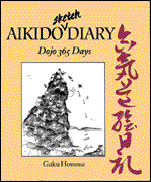 190 pages; $12.95 In Aikido Sketch Diary: Dojo 365 Days, Gaku Homma Sensei introduces readers to the annual round of events at Nippon Kan, where members can practice Aikido not only on the mat but also by participating in the many activities and volunteer programs in which the dojo is involved. “Aikido Sketch Diary is a documentary of a full year of practice at Nippon Kan. Each of the five sections outlines an aspect of life at this tradtionally-styled dojo,”writes Homma Sensei. Nippon Kan students learn that the ultimate goal of Aikido practice is not to develop the ability to vanquish opponents, but to learn to work in harmony with other human beings.
190 pages; $12.95 In Aikido Sketch Diary: Dojo 365 Days, Gaku Homma Sensei introduces readers to the annual round of events at Nippon Kan, where members can practice Aikido not only on the mat but also by participating in the many activities and volunteer programs in which the dojo is involved. “Aikido Sketch Diary is a documentary of a full year of practice at Nippon Kan. Each of the five sections outlines an aspect of life at this tradtionally-styled dojo,”writes Homma Sensei. Nippon Kan students learn that the ultimate goal of Aikido practice is not to develop the ability to vanquish opponents, but to learn to work in harmony with other human beings.
The Folk Art of Japanese Country Cooking
The Folk Art of Japanese Country Cooking: A Traditional Diet for Today’s World Published by North 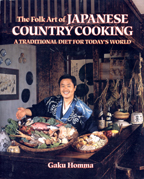 Atlantic Books, Berkeley, California; and Domo Productions, Denver, Colorado; 1991 Paperback; 276 pages; $22.95 The Folk Art of Japanese Country Cooking offers a unique look at not only Japanese cooking, but Japanese history and culture as well. Anyone interested in understanding more about Japan will find it an invaluable source of information. And for those who enjoy Japanse cooking, well, they’re in for a treat—or more accurately, hundreds of treats. The recipes are clear and easy to follow and include helpful illustrations.
Atlantic Books, Berkeley, California; and Domo Productions, Denver, Colorado; 1991 Paperback; 276 pages; $22.95 The Folk Art of Japanese Country Cooking offers a unique look at not only Japanese cooking, but Japanese history and culture as well. Anyone interested in understanding more about Japan will find it an invaluable source of information. And for those who enjoy Japanse cooking, well, they’re in for a treat—or more accurately, hundreds of treats. The recipes are clear and easy to follow and include helpful illustrations.
